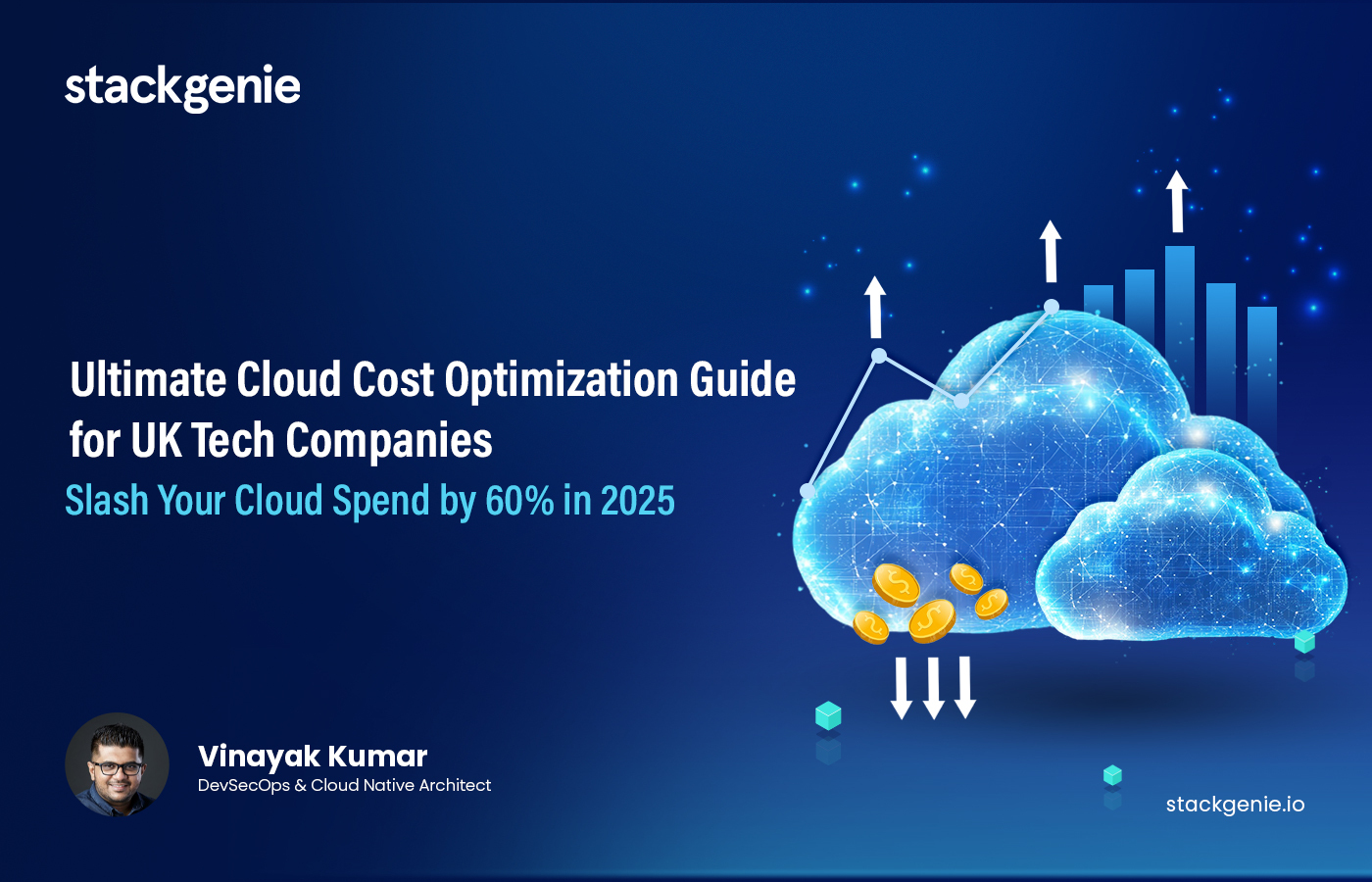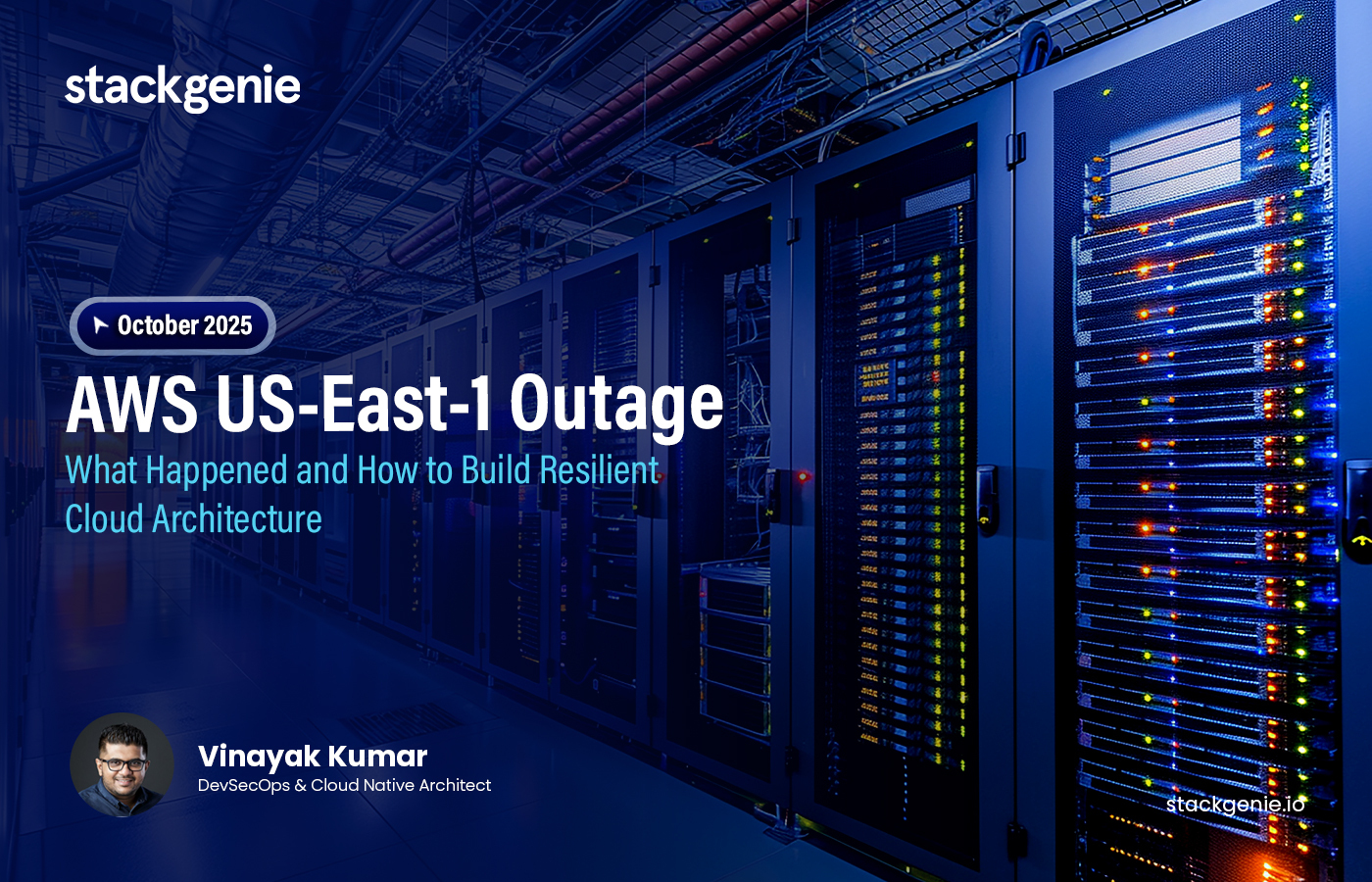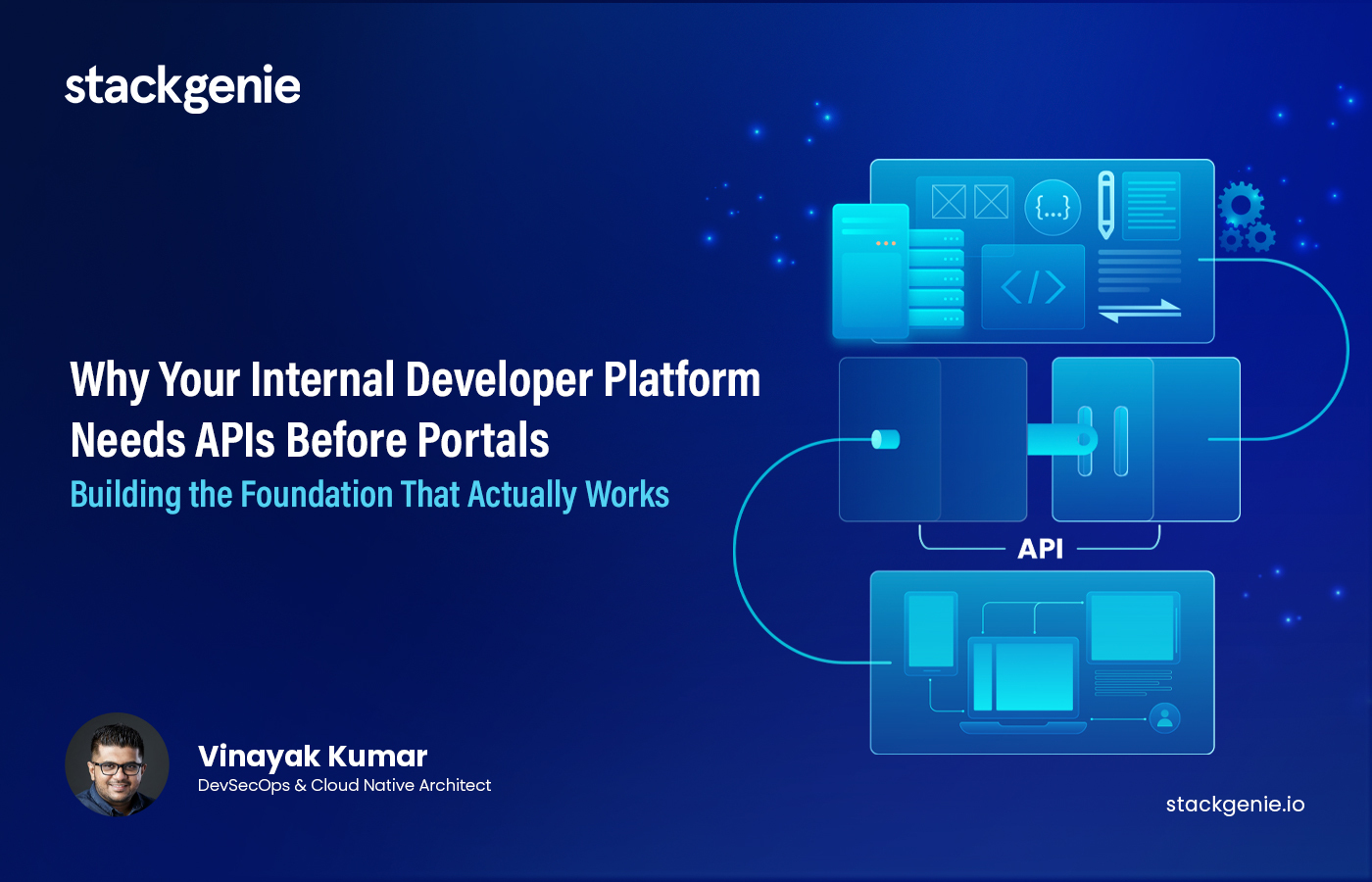Inside this article :
“We were burning through £15,000 monthly on AWS with nothing to show for it. After implementing proper cost optimization strategies, we cut our bill to £6,000 while improving performance. The savings funded our next two developer hires” — James Mitchell, CTO, London based FinTech Startup
Are cloud costs spiraling out of control? You’re not alone. Across the UK, from innovative startups in London’s Silicon Roundabout to scaling tech companies in Manchester and Edinburgh, businesses are grappling with a common challenge: how to harness cloud power without incurring significant costs.
The statistics are sobering. According to recent industry research, UK businesses waste an average of 35% of their cloud spend on unused or inefficient resources. For a typical scaling startup spending £20,000 monthly on cloud services, that’s £7,000 going straight down the drain every single month.
At Stackgenie, we’ve helped over 150 UK tech companies optimize their cloud operations through strategic Kubernetes consulting and comprehensive DevOps services. This definitive guide reveals the exact strategies that have saved our clients millions in aggregate cloud costs while improving performance and reliability.
Why Cloud Cost Optimization Matters More Than Ever for UK Businesses
The current economic climate has made efficient cloud spending a matter of survival. With venture funding tightening and growth expectations remaining high, UK tech companies must extract maximum value from every pound spent on cloud infrastructure.
Consider these UK specific challenges:
- Currency Fluctuations: GBP volatility affects dollar denominated SaaS pricing
- Compliance Costs: GDPR and data sovereignty requirements add complexity
- Talent Competition: High developer salaries in London and other UK tech hubs
- Market Pressure: Aggressive competition requiring rapid scaling capabilities
Companies that master cloud cost optimization gain a significant competitive advantage—freeing up capital for innovation, talent acquisition, and market expansion.
Phase 1: Comprehensive Cloud Spend Analysis and Baseline Assessment
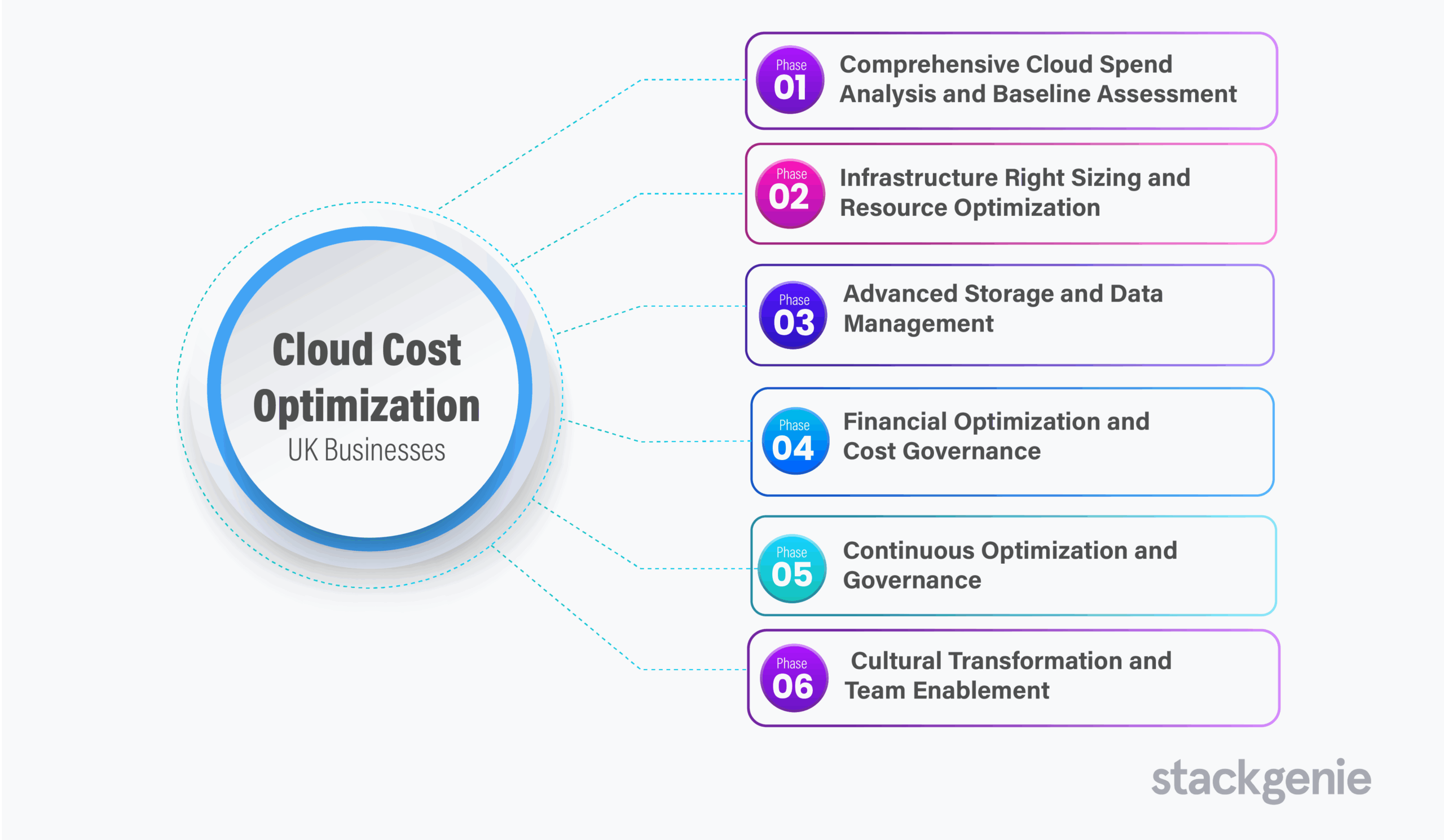 1. Conduct a Forensic Cloud Audit 🔍
1. Conduct a Forensic Cloud Audit 🔍
Before optimization comes with understanding, most UK businesses operate cloud infrastructure with surprising blind spots about where the money actually goes.
Essential Audit Actions:
- Deploy Cloud Billing Analytics: Implement AWS Cost Explorer, Azure Cost Management, or Google Cloud Billing for granular visibility.
- Resource Tagging Strategy: Tag all resources with environment (dev/staging/production), team ownership, project codes, and cost centers
- Identify Zombie Resources: Hunt down unused EC2 instances, unattached EBS volumes, and orphaned load balancers.
- Analyze Usage Patterns: Map demand cycles to understand peak vs. off peak resource needs.
Stackgenie Insight: Our audits regularly uncover UK technology companies running development environments 24/7 that could be automatically shut down during nights and weekends—immediately saving 65% on non production costs.
2. Establish Cost Accountability Through Organizational Alignment 📊
Transform cloud spending from an IT expense to a business investment through clear accountability structures.
Implementation Framework:
- Team Level Cost Allocation: Assign cloud costs to specific development teams and projects
- Monthly Spend Reviews: Establish regular cost review meetings with engineering leads
- Budget Thresholds: Set department level spending limits with automated alerts
- Performance Metrics: Track cost per user, cost per transaction, and cost per feature
UK Specific Consideration: Many UK tech companies discover their compliance heavy industries (fintech, healthtech) can optimize costs while maintaining regulatory requirements through proper resource allocation.
Phase 2: Infrastructure Right Sizing and Resource Optimization
3. Strategic Compute Resource Optimization 🎯
Overprovisioning remains the most common cloud waste pattern among UK businesses.
Advanced Right Sizing Techniques:
- CPU and Memory Analysis: Use CloudWatch, Azure Monitor, or Stackdriver to identify consistently underutilized instances
- Instance Family Optimization: Match workload characteristics to appropriate instance types (compute optimized, memory optimized, storage optimized)
- Spot Instance Integration: Implement spot instances for fault tolerant workloads like batch processing and CI/CD pipelines
- Graviton Processors: Leverage AWS Graviton2 instances for up to 40% better price performance
Kubernetes Specific Optimization:
- Deploy Vertical Pod Autoscaler (VPA) for automatic resource request adjustment
- Implement Horizontal Pod Autoscaler (HPA) for dynamic scaling based on metrics
- Use node selectors and affinity rules to optimize pod placement
- Deploy cluster autoscaler for automatic node provisioning
4. Implement Intelligent AutoScaling Architecture 🚀
Replace manual scaling with automated, demand nresponsive infrastructure.
Auto Scaling Best Practices:
- Predictive Scaling: Use historical data to pre scale for anticipated demand
- Multi Metric Scaling: Scale based on CPU, memory, and custom business metrics
- Scheduled Scaling: Automatically scale for known patterns (business hours, seasonal trends)
- Cross Region Scaling: Distribute load across UK regions for optimal performance and cost
Serverless Integration Strategies:
- Migrate appropriate workloads to AWS Lambda, Azure Functions, or Google Cloud Functions
- Implement API Gateway with auto scaling for microservices architectures
- Use serverless containers (AWS Fargate, Azure Container Instances) for event driven workloads
Phase 3: Advanced Storage and Data Management Optimization
5. Comprehensive Storage Lifecycle Management 🗄️
Storage costs often represent 20 – 30% of total cloud spend but receive insufficient optimization attention.
Storage Optimization Strategies:
- Automated Lifecycle Policies: Configure S3 Intelligent Tiering, Azure Blob lifecycle management, or Google Cloud Storage lifecycle rules
- Data Archival: Move infrequently accessed data to cheaper storage classes (Glacier, Cool Blob, Nearline)
- Snapshot Management: Implement automated deletion of outdated snapshots and backups
- Compression and Deduplication: Reduce storage requirements through data optimization
Database Specific Optimization:
- Right size RDS instances based on actual performance metrics
- Implement read replicas strategically to reduce primary database load
- Use reserved capacity for predictable database workloads
- Consider serverless database options (Aurora Serverless, Cosmos DB serverless)
6. CI/CD Pipeline Cost Optimization 🔧
Continuous integration and deployment pipelines can consume substantial resources if not properly managed.
Pipeline Efficiency Strategies:
- Ephemeral Build Environments: Use containers or serverless functions for builds
- Build Agent Optimization: Implement auto scaling build agents that scale to zero
- Parallel Processing: Optimize build parallelization to reduce overall build time
- Artifact Management: Implement retention policies for build artifacts and container images
UK Specific Implementation: Many UK companies benefit from scheduling builds during off peak hours to take advantage of lower spot instance pricing.
Phase 4: Financial Optimization and Cost Governance
7. Strategic Reserved Capacity and Savings Plans 💷
Transform variable costs into predictable, discounted expenses through strategic commitments.
Commitment Strategy Framework:
- Workload Analysis: Identify stable, long running workloads suitable for reserved capacity
- Commitment Sizing: Start with 60 – 70% of baseline usage to avoid over commitment
- Multi Year Planning: Align reserved instance terms with business growth projections
- Portfolio Optimization: Mix reserved instances with savings plans for maximum flexibility
Financial Planning Considerations:
- Account for GBP/USD exchange rate fluctuations in cost projections
- Consider quarterly payment options to improve cash flow management
- Implement reserved instance exchanges for changing requirements
8. Comprehensive Subscription and Licensing Audit 🔐
Third-party tools and services often represent hidden cost optimization opportunities.
Subscription Optimization Process:
- Usage Analysis: Audit actual usage of monitoring, security, and development tools
- Redundancy Elimination: Identify overlapping tools serving similar functions
- Open Source Alternatives: Evaluate OSS replacements for expensive proprietary tools
- Vendor Negotiations: Leverage usage data for better contract terms
Recommended Open Source Alternatives:
- Monitoring: Prometheus + Grafana instead of expensive APM solutions
- CI/CD: GitLab Community Edition or Jenkins instead of premium build services
- Security: Open Policy Agent for Kubernetes policy management
- Logging: ELK Stack for centralized log management
Phase 5: Continuous Optimization and Governance
9. Automated Cost Monitoring and Alerting 🚨
Implement proactive cost management through intelligent monitoring and alerting systems.
Monitoring Infrastructure:
- Multi Dimensional Alerts: Set up alerts for spend increases, unusual usage patterns, and budget thresholds
- Anomaly Detection: Use machine learning based anomaly detection for cost spikes
- Real Time Dashboards: Create executive dashboards showing cost trends and optimization opportunities
- Integration with Communication Tools: Connect alerts to Slack, Microsoft Teams, or email for immediate visibility
Governance Framework:
- Establish spending approval workflows for new resources
- Implement cost budgets with automatic enforcement
- Create cost center hierarchies aligned with organizational structure
- Generate automated monthly cost reports for stakeholders
10. Quarterly Cloud Cost Optimization Reviews 📅
Institutionalize cost optimization through regular, structured review processes.
Review Meeting Structure:
- Cost Trend Analysis: Review spending patterns and identify emerging cost drivers
- Optimization Opportunity Assessment: Evaluate new cost saving opportunities
- Architectural Review: Assess whether current architecture aligns with cost goals
- Commitment Planning: Plan future reserved capacity and savings plan purchases
Key Performance Indicators:
- Cost per user/customer
- Cost per transaction
- Infrastructure cost as percentage of revenue
- Month over month cost growth rate
Phase 6: Cultural Transformation and Team Enablement
Building a Cost-Conscious Engineering Culture 🧠
Sustainable cost optimization requires cultural change beyond technical implementation.
Cultural Transformation Strategies:
- Cost Awareness Training: Educate development teams on the cost implications of architectural decisions
- Performance Metrics: Include cost efficiency in individual and team performance reviews
- Gamification: Create friendly competition around cost optimization achievements
- Decision Making Integration: Include cost considerations in architectural review processes
Best Practices for UK Teams:
- Implement “cost per feature” metrics to inform development prioritization
- Create cost conscious coding guidelines and best practices
- Establish cost impact assessments for major architectural changes
- Reward teams that achieve significant cost optimizations
Real World Results: What Technology Companies in UK Can Expect
Based on our extensive experience with UK tech companies, here are typical optimization outcomes:
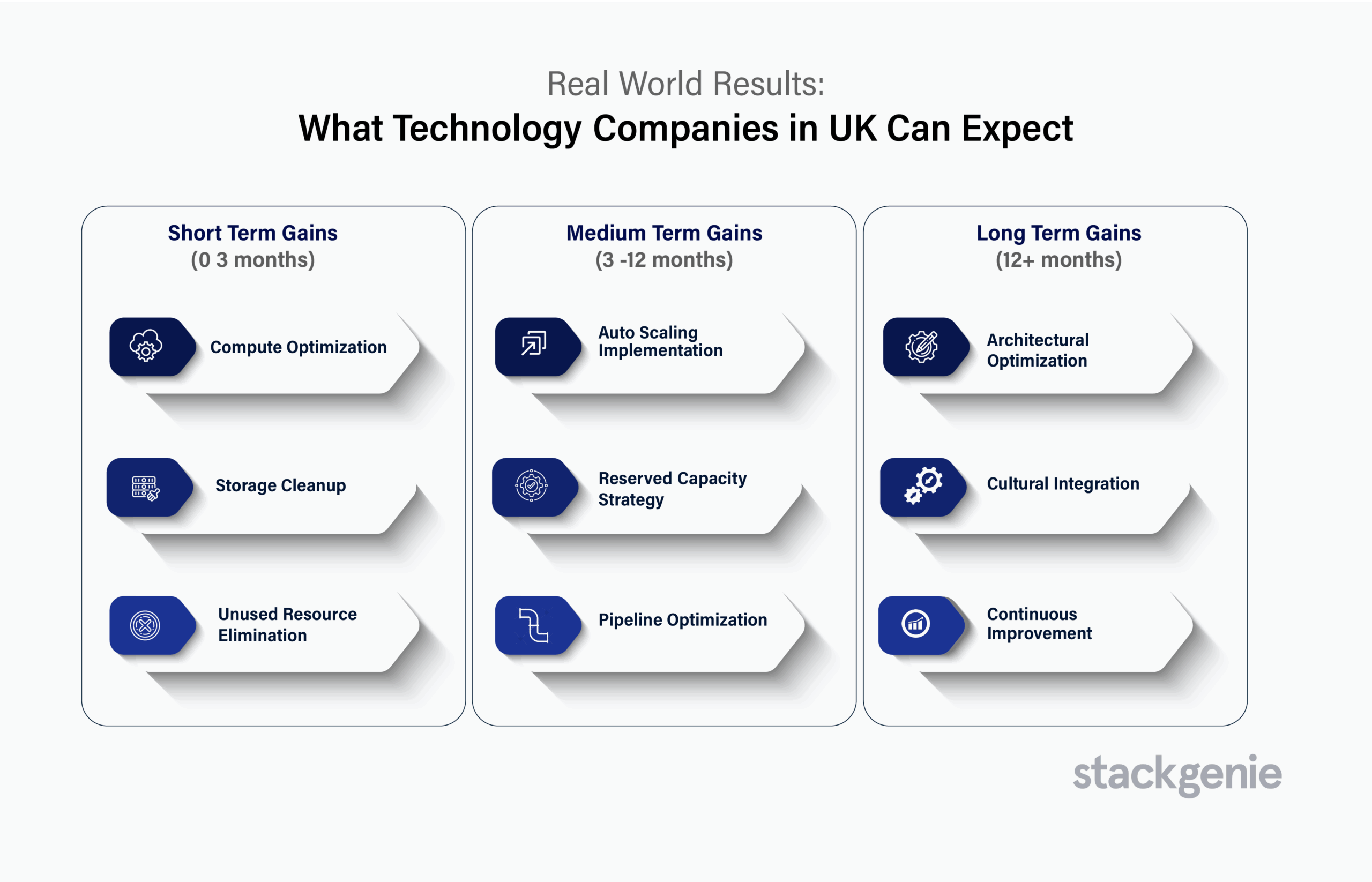
Short Term Gains (0-3 months):
- Compute Optimization: 25-45% reduction through right sizing and spot instances
- Storage Cleanup: 20 -35% savings from lifecycle management and data archival
- Unused Resource Elimination: 15- 25% savings from identifying and removing waste
Medium Term Gains (3-12 months):
- Auto Scaling Implementation: Additional 20 – 30% savings through demand responsive infrastructure
- Reserved Capacity Strategy: 40 – 60% savings on predictable workloads
- Pipeline Optimization: 30 – 50% reduction in CI/CD costs
Long Term Gains (12+ months):
- Architectural Optimization: 20 – 40% additional savings through cloud native architecture
- Cultural Integration: Sustained cost discipline preventing future waste
- Continuous Improvement: Ongoing optimization yielding 5 – 10% annual improvements
Industry-Specific Optimization Strategies
FinTech Companies
- Implement PCI DSS compliant cost optimization without compromising security
- Leverage UK specific financial services cloud frameworks
- Optimize high frequency trading infrastructure for cost and performance
HealthTech and Life Sciences
- Navigate NHS data requirements while optimizing costs
- Implement GDPR compliant data lifecycle management
- Optimize clinical trial data processing workloads
E commerce and Retail
- Handle seasonal demand spikes cost effectively
- Optimize recommendation engines and analytics workloads
- Implement dynamic pricing based on infrastructure costs
SaaS and Software Companies
- Align infrastructure costs with customer metrics
- Optimize multi tenant architecture for cost efficiency
- Implement usage based pricing models
Implementation Roadmap: Your 90 Day Cost Optimization Plan
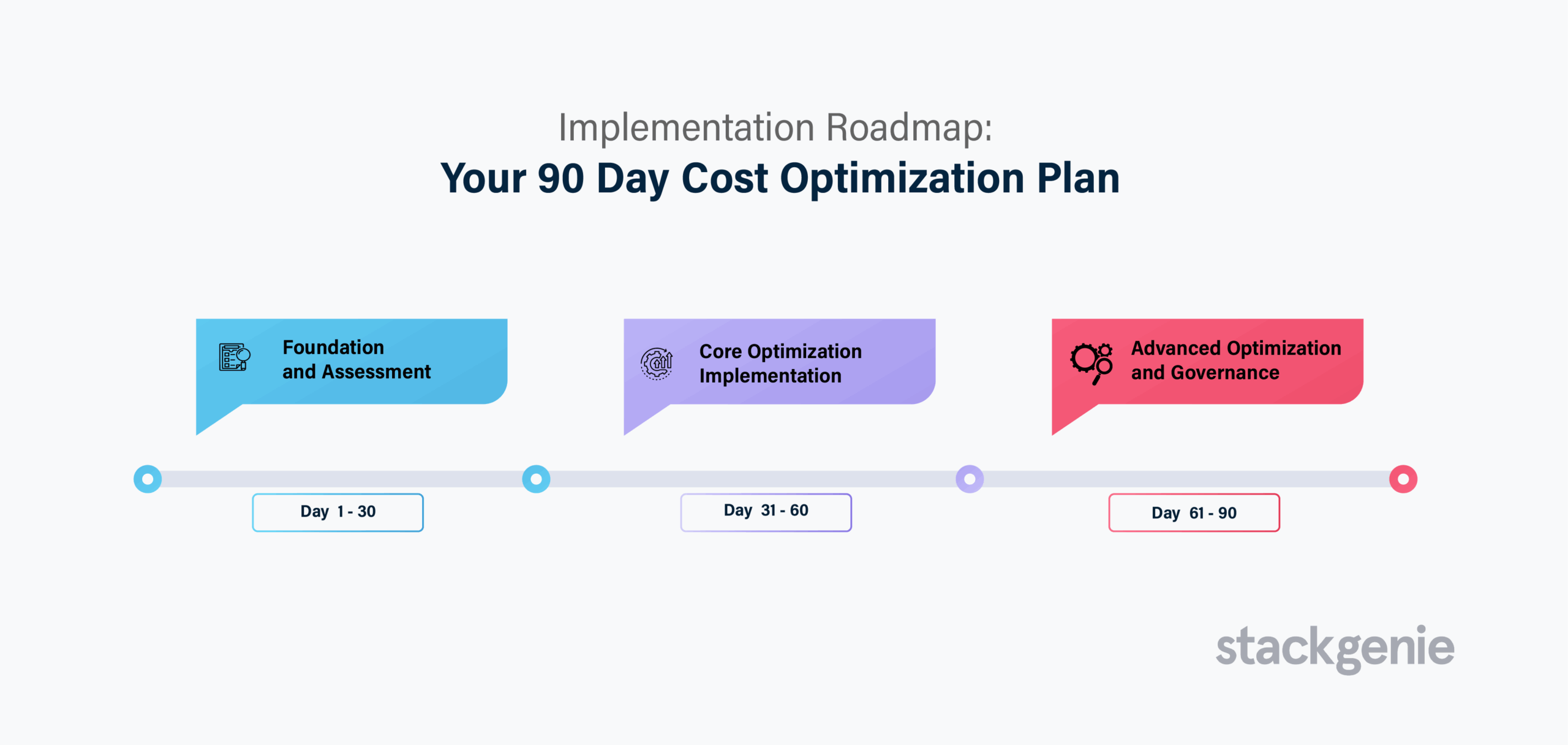
Days 1-30: Foundation and Assessment
- Complete comprehensive cloud audit
- Implement resource tagging strategy
- Set up cost monitoring and alerting
- Identify quick wins for immediate savings
Days 31-60: Core Optimization Implementation
- Right size compute resources
- Implement auto scaling where appropriate
- Clean up storage and optimize lifecycle policies
- Deploy reserved capacity for stable workloads
Days 61-90: Advanced Optimization and Governance
- Implement advanced monitoring and alerting
- Establish regular review processes
- Begin cultural transformation initiatives
- Plan next phase of architectural optimization
Why Choose Stackgenie for Your Cloud Cost Optimization Journey
We at Stackgenie brings unique advantages to Technology companies in UK seeking cloud cost optimization:
Deep UK Market Expertise
- Understanding of UK regulatory requirements (GDPR, Financial Services regulations)
- Experience with UK specific business challenges and market dynamics
- Local presence with London based team for on site support when needed
Proven Methodology
- Proprietary cost optimization framework refined through 150+ client engagements
- Industry specific optimization strategies tailored to UK business needs
- Comprehensive approach covering technical, financial, and cultural aspects
Ongoing Partnership
- Continuous optimization support beyond initial implementation
- Regular review and refinement of cost optimization strategies
- Access to latest cloud cost optimization tools and techniques
Comprehensive Service Portfolio
- Kubernetes Consulting: Expert guidance on container orchestration and optimization
- DevOps Consulting: End to end DevOps transformation and optimization
- Cloud Architecture: Design and implementation of cost effective cloud solutions
- FinOps Implementation: Complete financial operations for cloud management
Getting Started: Your Next Steps
Free Cloud Cost Assessment
Book a complimentary 45 minute cloud cost review with our UK based experts:
- Analyze your current cloud spending patterns
- Identify immediate optimization opportunities
- Receive a customized optimization roadmap
- Learn about potential savings specific to your industry and use case
Comprehensive Optimization Engagement
For companies ready to implement comprehensive cost optimization:
- 90 day intensive optimization program
- Dedicated team of cloud and Kubernetes experts
- Guaranteed minimum cost savings (typically 30 – 50%)
- Ongoing support and optimization maintenance
Contact Information
- Website: stackgenie.io
- Email: [email protected]
- Phone: +1 9176720197
Conclusion: Transform Your Cloud Costs, Transform Your Business
Cloud cost optimization isn’t just about reducing expenses—it’s about creating sustainable competitive advantage. UK tech companies that master cost optimization today build the financial foundation for tomorrow’s growth and innovation.
The strategies outlined in this guide have helped UK businesses save millions in aggregate cloud costs while improving performance, reliability, and team productivity. From London startups to Manchester scale ups, Edinburgh enterprises to Bristol innovators, the principles remain consistent: systematic analysis, strategic optimization, and cultural transformation.
Don’t let cloud costs constrain your business potential. Take the first step toward optimized cloud operations and unlock the resources needed to fuel your next phase of growth.
